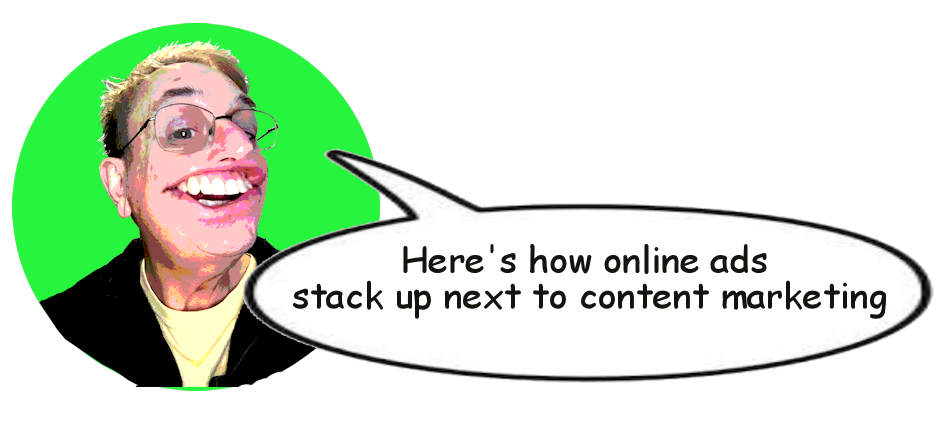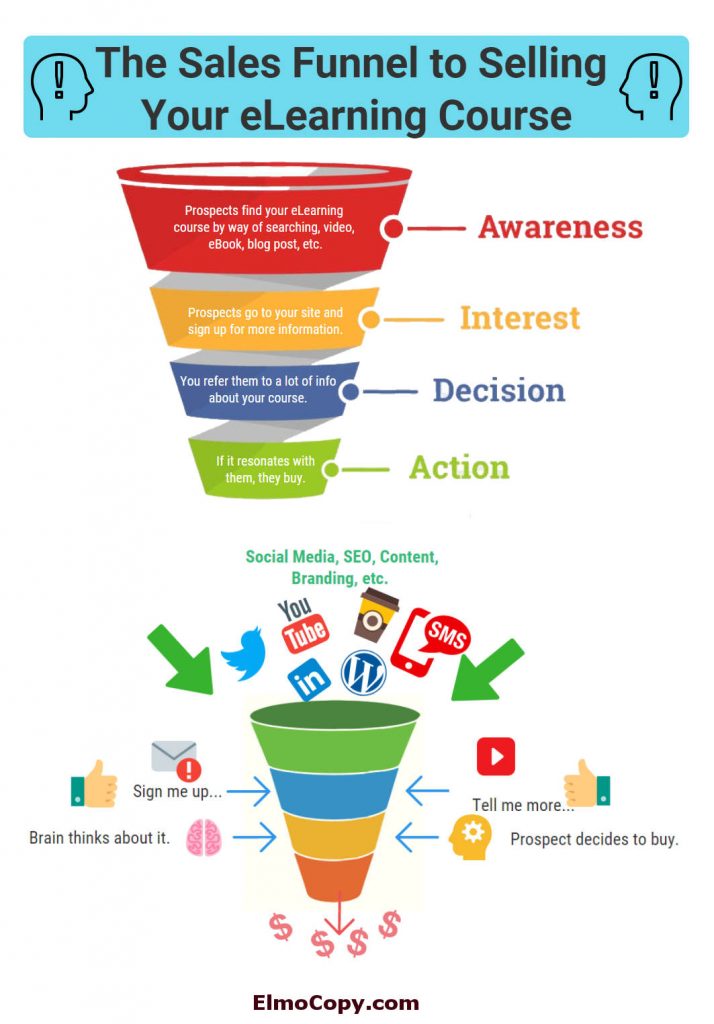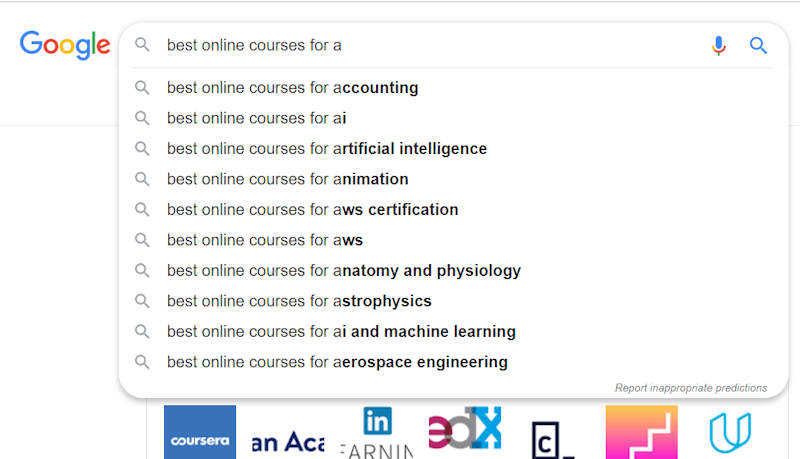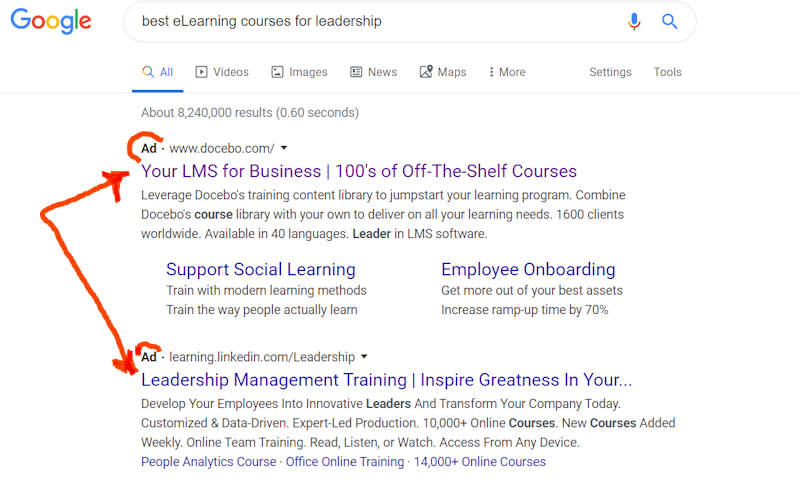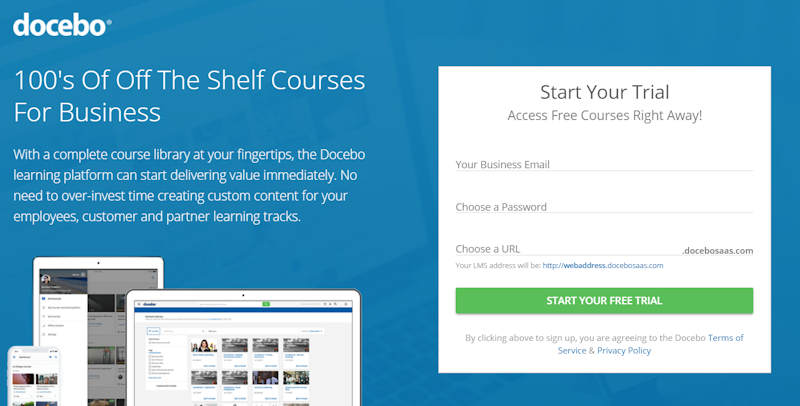Congrats on creating an eLearning course!
It takes a lot of hard work and guts to build a digital system that can train or educate people.
Now comes the real work – you’re going to have to go out there and market the crap out of it.
Sorry, I’ll bet you thought you were done…
That’s OK, I’ve got the solution for you.
In this post, I’m going to give you 6 ways you can use content marketing to promote your eLearning or gamification program or services.
Is content marketing the only way to sell your eLearning course?
Nope.
But it’ll get you closer to your marketing goals, that’s for sure.
Why Use Content Marketing to Push Your eLearning Course?
Content marketing should not be the only way to promote your eLearning course or services; it should be a part of your marketing mix.
Here are my reasons:
Content Marketing is a Lot Cheaper Than Paid Ads
I don’t want you to think for a second that content marketing is cheap.
Even if you’re writing your content, it’s not free. (Unless you don’t place any value on your time at all.)
It takes a lot of time and effort to put out great content. I’ve never written a great piece of content in under less than 4 hours.
Why does it take so long?
Because when you’re writing content, you have to:
- Research your topic
- Find relevant links to reinforce your content
- Create interesting graphics and infographics
- Write the draft
- Refine your content
- Format it for the venue you’re writing for
- Promote it
- Do keyword research
- Perform another keyword research tactics
It also takes a lot of thinking and planning to make sure your content is competitive online.
Most of the companies who are killing it in their marketing space have sense enough to hire a copywriter to do it for them.
And they pay well for the content because they see the value in it.
Content Marketing VS Paid Advertising
Let’s do a very simple comparison of content marketing to paid advertising on Facebook.
According to WordStream on average across all industries, those ads will run you $1.72 per click.
Let’s say you run that ad for a week and you generate 100 clicks. That means you’ve spent $172.00 in a week. Multiply that by 4 weeks in a month and you’re out $688.00.
If you were to continue using Facebook ads over a year, you’ll have spent $8256.00
Let’s contrast that with content marketing.
To get a 1500-word piece of content written for your business it can run you anywhere from $200 up to $500.
On the low end, you can get 10 pieces of content for $200 = $2000.
Up in the high end, 10 pieces of content for $500 will be in the $5000 range.
So even if you went in on the high end, you’d still save about $3,356.00 at the initial outlay of cash.
The reason why I used Facebook ads in this example, is because it is the conservative side of ad costs.
If I had used Google’s ads the average would have been higher. According to Valve and Meter, the average cost per click across all industries is $2.69.
So instead of $172 spent for 100 clicks on Facebook ads, you’d be spending $269 a week with Google for the same number of clicks. That would be $1076 in a month, and in a year you would have spent $12,912.
So, you’ll have saved close to $5000 with a copywriter.
The Real Value of Using Content Marketing to Sell Your eLearning Course
Once again, let’s compare content versus ads in promoting your eLearning course or gamification software.
Online Ads – Initial Contact
You run an ad promoting your eLearning course and prospects click on them.
(Preferably the ad is written by a copywriter who knows how to write ads that get the clicks you need. Hopefully, your company’s competitors aren’t just clicking on your ads to drive up your costs. Either way, it’s more money flowing out of your pocket.)
Your prospects go to your sales page and make a decision.
Content Marketing – Initial Contact
Your prospects find your content and read how it can benefit them and change their lives somehow. If the content resonates with them they also make a decision. At the bottom of a blog post, for instance, they’ll have a chance to comment or ask questions.
(Once the content has been written and paid for the prospect will have to come across it by way of good SEO. It also takes time for content to get to the top of the search engine results pages if it’s good.)
Online Ads – Duration of Event
Once the ad has been clicked on and goes to the sales page, it’s pretty much over. Nice and simple.
Content Marketing – Duration of Event
Once the prospect finds the content and reads it they can comment on it share it, curate it, etc.
Online Ads – Long Term Costs
With online ads, you have to keep paying every time someone clicks on the advertisement. If you stop paying for them, the ads go bye-bye.
Content Marketing – Long Term Costs
With content, as long as it sits on the Internet it’s there forever. If you keep your website paid up and running your content will stay online forever. If you’re guest posting or posting on an external platform like LinkedIn, your content will be there indefinitely for free.
Online Ads – Relevance
One of the big problems with online advertisements is they interrupt the activity of the person searching for information. Whether it’s flashing ads on a side menu, a pop-up box, or ads disguised as content, they are usually an unwelcome pest.
Content Marketing – Relevance
When a person clicks on a link to read your content they are doing it voluntarily. They are looking for what you seem to be putting out. Your headline or title is seen in the search engine results or someone posted it on social media and it looks like what they’ve been looking for.
However, you can screw this up…
You could have a compelling headline that draws them into your site and the content sucks or is irrelevant. (Another good reason to hire a copywriter to write your posts.)
Online Ads – Other Uses
I don’t think you can use the same online ads for different things. They are what they are. If you know someone that can use them for other than what you paid for them, please let me know.
Content Marketing – Other Uses
You can repurpose the content you have written.
Man, can you repurpose it!
Here’s a list of the different ways you can do this to promote your eLearning course:
- Blog Posts
- White papers
- Turn it into a video
- eBooks
- LinkedIn social updates
- Multiple Tweets
- Facebook curation
- Podcast content
- PowerPoint presentations
- Slideshare presentations
- Infographics
- Video graphics
- Video talk show
- Webinar
- Case Study
- Book Chapter
- Printed books
- Email newsletter
- Course content
- Posts for Quora or Reddit
This list can go on and on, but you get the picture.
Online Ads – SEO Benefits
Unfortunately, ads will not bring your website any SEO benefits no matter how much you paid for them.
Content Marketing – SEO Benefits
However, every time you have content added to your site, Google will index it. Blogs are the best way to get more content onto your site because any content you produce with a blog will be added to the content you’ve already posted. So if you add 10 blog posts, each one of those posts will be on a search engine’s radar.
(Just imagine if you add a blog post at least twice a month!)
If you get well-written posts onto your site, they’ll have a good chance of getting more traffic to your website. As I mentioned earlier, those posts will remain online indefinitely.
Hopefully, by now you can see the value behind using content marketing. Next, we’re going to get into the actual nuts and bolts of putting together a marketing system to get your eLearning course into the hands of prospective students.
What We Can Learn From Older Marketers
I have seen a lot of different ideas on how products like eLearning courses should be marketed. eLearning courses are actually information products that have been upgraded by the Internet.
Rather than just digesting the course information, you can now have an interactive system that teaches you with games and quizzes that are responsive to your answers. Even though the training is more advanced, the methods of selling them are pretty much the same.
Prior to the Internet getting into most homes, courses of every kind were sold through the mail.
One of the top dogs in the information marketing field was an uber-marketer named Dan Kennedy. Not only does he sell all kinds of courses through the mail, but he gives seminars at $2000 to $5000 + per person.
He is a millionaire at selling these things and he teaches others how to do it as well.
However, his way of marketing a course or information product is different from what most people would try to sell. He’d tell you to market your course first AND THEN create it.
Yep, you read that right. You’d start marketing your course first it AND THEN make it.
His method is to do the entire process backward.
Here’s an example of what I mean by backward process:
Before you create your course you need to come up with the idea for it and conceptualize it somewhat.
Next, you build a sales page that offers the eLearning course you’ve come up with. On your sales page, you offer a freebie of some sort in return for your prospect’s email addresses.
For example, you can offer a free eBook that gives a hint or some information about your eLearning course is about.
You then run a test by taking out ads on a site like Facebook or Google targeting your sales page.
If the response is good and a lot of people sign up to get the free ebook, go ahead and build the course. If you get a crappy response and that dog won’t hunt, you can ditch the idea before you commit to building the entire course.
The main idea behind this is to see if there’s a need for the course before you waste a lot of time building it.
OK, I know what you’re thinking. You’re thinking won’t the people get mad if I don’t actually have the course yet? As long as you’re not taking money from them, you’ll be fine. You don’t want to sell anything that you don’t already have. Some of the marketers that use this method will actually make a free lesson or ebook and then sell that or just buck or two.
If you’re going to do it that way, make sure you’re exchanging good value for the money you’re taking in.
Getting Started Promoting Your eLearning Course with Content Marketing
If you have the best course in the world, and no one knows about it, you won’t make money with it. So you have to know how to promote and sell your course.
There are several things ways you can accomplish this.
The Sizzle Method – Build the Anticipation
Once again, veteran marketers like Dan Kennedy use these tactics all the time and they’ve been doing it before the Internet became a thing in your home.
This is where you give a lot of the”sizzle” and not much of the steak.
With this method, you’re going to create anticipation for your product before you release it. You could create an email series, a group of YouTube videos, or a newsletter delivered in the mail.
Here’s How it Works:
You start talking about the set of problems your eLearning course solves by creating a series of messages.
In this case, let’s use email as a good example.
(In this example, I’m going to use an actual email series I got from one of the veteran marketers who was promoting his “Real Estate Millions” course.)
If you want to know how this method works, just get on a marketer’s email list. In my case, I collected the real estate guru’s email drip over a period of several months.
It was easy getting on his list, he was offering a free recording of how he became a millionaire in real estate within 4 years. So I went to his site and signed up.
Within seconds of signing up, I get the first email from him with a link to the audio recording on it.
Email #1: Here’s the Book and CD you requested!
This email had a cheerful “congratulations” in it for having the guts to take action by requesting this life-changing information.
In it was also a link to either download the audio files or get the eBook which was a transcription. Since I’d rather read, I opted for the 200 page eBook.
Guess what the message was on almost every page?
Yep, how he became vastly rich in the real estate market and how it all started because he took a course on investing in real estate.
He also told me how it could change my life a bunch if I did the same thing
No kidding.
Of course, there was virtually NOTHING on how this would all happen.
Email #2: Do You Have It?
The psychology behind this is to challenge my self-worth by asking me if I’m good enough to become rich.
After that, there was a laundry list of things successful people do…like “Take Action” and then he briefly mentioned a course he has.
Once again, there was NOTHING said on how this would all happen.
Email #3: Here’s What Jennifer Said…
In this email, the guru talked about one of his students and how they became successful in investing in real estate.
She gave the usual rags-to-riches story giving all the glory to the guru and his methods of teaching real estate investing with his course.
However, at the end of this message, the guru offered a $99 (not $100, mind you) packet to “get acquainted” with his methods.
I did not bite on the offer because it would have told me just enough to want to take the full course.
Key point: Everything including the $99 packet is leading you to the course. All messages must have a focus on your eLearning course if you are going to market it and sell it.
Email #4: What’s in the Gap?
This time, the guru apologized for leaving a gap in his message. He tells me in this email that he forgot to mention what the $99 package had in it.
He also mentions how he’s making so many millionaires all over America. (And how did he do that? Was it a course?)
Next, he offers me an extra $199 (not $200 mind you) of training if I jump on the $99 “Get Acquainted” package he offered me in the last email.
Now I would have felt like a real schmuck if I had taken the $99 deal and missed out on the extra $199 of training.
Note: There’s a thing in most automatic email sending programs called “segmenting”. If I had gotten the $99 deal, I would get a different email series than folks that didn’t sign up. That way, I wouldn’t know about the $199 deal and get mad because I didn’t get in on it.
Segmenting is a powerful way to do your email campaigns If you’re using an online emailing system like Aweber or Constant Contact you should use their segmenting tools to make sure you are specifically hitting the right targets.
Email #5 And Beyond – Are You Puzzled?
The next emails I received in the series were more sizzle and none of the steak. The entire focus was on taking the course at some time or other. Of course, I’m not going to go into detail on each email but here’s a list of subject lines from each one:
- Are You Puzzled?
- Last Chance
- Must Read
- Here’s a Real Estate Calculator
- Time Sensitive Invitation
- Broaden Your Horizon
- Did You See This?
- Tonight’s Webinar
- Don’t Forget the Webinar
- A Decision to Change Your Life
I’ve gotten a total of 37 of these emails since last August. Every single one of them talks about…the course.
When you think about it, this method makes sense because our minds are wired for it.
Would you approach a candidate for a date without getting to know the person first? Of course not. You have to know whether he or she is right for you and if they have the same interests as you do.
Car buying is the same thing. Would you go out and buy just any car without eventually settling on the one right for you?
What You Need to Know In Order to Promote Your eLearning Course
You could easily take the same approach to create a series of videos. You could have a welcome video and just give the “sizzle” out over a period of time.
Also, make case studies of people who took your course and got results or interviews of these people in your own video series.
Just like in the email examples above, you could sell several lessons on one of the videos as a cheaper course. (As I mentioned earlier, this would still lead to the bigger course.)
Remember how I told you a while back how you can repurpose content? You can do the same with this method of promotion for your eLearning course. ( Or gamification software, for that matter.)
You could repurpose any of the content and turn it into a series of reports, SlideShare presentations, videos, infographics, or whatever you want.
How to Learn This Tactic From the Pros
Learning from the big boys is easy to do.
Run a Google search for ” Best Online Courses” or you can fill in your niche “Best Online Courses for Leadership” or “Best Online Courses for *“.
See where I put the asterisk (*)? Put a letter in its place, like this: “best online courses for a.”
Google’s automatic search function gave me these ideas to choose from:
Notice how Google gave you all sorts of search suggestions for the letter “a”?
You can also do the same with the entire alphabet.
Once you’ve found a niche similar to yours, take a look at the ads on the page. Let’s pretend for a second that you’re doing a search for the term “best eLearning courses for leadership”
Click on the ones with the ads because they are probably the most serious businesses; they’re paying for their advertising so chances are they’re very good at what they’re doing.
I clicked on the first one to see what they were offering me to enter their sales funnel.
Hey, Docebo is offering free lessons right off the bat.
Goody!
Once you type your information into the opt-in box and hit the “Start Your Free Trial” button, you’ll get an email campaign that will be focused on getting you to take the entire course.
D0 This Right Now…
You want to do a search of different eLearning niches and get on their mailing lists to see what methods they’re sales funnels are employing. Google a bunch of them and especially click on the ones that are running ads on the search results pages.
These are businesses that are spending a lot of money on advertising so they’ll probably have great email campaigns and sales funnels for you to swipe ideas from.
How You Can Use the “Free Lesson” Method to Market Your eLearning Course
Once you understand how this method of tempting your prospects with enticing information, you can go a long way with it.
One thing you can do is create a few lessons and give them away for free. Before you run off to do this there are a few things you need to do first.
First, make sure that your lessons are world-class. If you’re using video, make sure it is a professional and clean as possible.
You don’t want to have an explainer video that looks like this:
Second, you want to start building your reputation as an authority. You must make sure you are in the video as the leader of the instruction. Whether you’re introducing a section of learning or making a point.
You’ll also want to look as professional as possible in these videos.
Also, make sure that you have a professionally written script for your videos.
Bad looking off the cuff videos makes you look like a guru wannabe. There are millions of people cranking them out and a lot of times the productions suck.
I don’t care how much money you’ve made, if you’re sitting in a T-shirt next to a big pile of money running your mouth without a script, I’m not buying it.
Let’s compare 2 videos so you can see what I mean.
Video 1
In my opinion, this video is poorly made. Considering the fact that he’s bragging about how much money he’s making, you’d think he could spend a little of it on decent video equipment.
The sound is shabby, the camera is too far away, and he’s dressed too casually. Honestly, I can overlook the fact that he’s wearing a T-Shirt if he could get to his point a lot faster and keep me there.
Since it took him a long time to get to his point, I just clicked off after several minutes. As far as an entrepreneurial video is concerned this is not too good.
(I swear, if I see one more money-making guru show me a stack of money, I think I’ll puke. It’s been done so many times already that it doesn’t impress anyone.)
Video 2
Neil Patel knows how to make a video that knocks the ball out of the park. He’s usually dressed professionally, the lighting and sound on his video are television quality, and he sounds like he has a planned script.
Not only that, but he has a beginning, middle, and end to his videos.
He has animated words that highlight what he’s talking about and an introduction that tells you exactly what the content is going to be.
But the one thing he does which most marketers don’t is he gives you actionable steps that you can use right away. And not only that but if you follow his advice and action steps you’d get results.
I know what you’re thinking. If he’s giving away all of this free information, how does he make money? Neil Patel knows that a lot of big companies will see his expertise and hire him as a consultant. Because he has so much outstanding content in his blog posts and videos, he is clearly seen as a market leader.
Not only that but he’s a serial entrepreneur with a series of successful companies under his belt.
Yeah…I guess that helps.
Recapping These Actions Steps to Market Your eLearning Course
Here’s how you can start selling your eLearning course immediately following some of the tips we’ve already covered.
This is all based on the idea that you already have thought your course through and if you’ve at least fleshed out a couple of lessons.
Step 1: Create Something to Give Away
You could create a free eBook to give away, but that’s so overdone it’s almost cliche. My advice to you is to create 3 great introduction lessons and give those away instead. You’ll need to make them professionally with incredible content your users can actually apply to their lives somehow.
You can send it out either by email lessons, have a link to videos, or send them to a learning management system (LMS) where they can actually experience your course.
Step 2: Set Up a Sales Page for Your Course
You’re going to need to create a landing page for your eLearning course whether you have the whole thing built or not. You could build a free Facebook business page or get a URL on a cheap WordPress site.
You need to look at a lot of eLearning sites. You’ll want to create a site with an opt-in box that offers something of value to your site’s visitors. Once again, I would hire a direct response copywriter to write the sales page. It takes years to get good at this type of writing and if you are creating content for your course, you won’t have time to do it yourself. Once you have a site set up, it’s time to go on to the next step…
Step 3: Use Ads Short Term to See If Your Course Will Sell
You remember near the beginning of this post how I told you to consider marketing your eLearning course with content instead of ads? I’m still standing on that. But my advice to you is to use ads short term to see if there is interest in your course.
Think about this for a second. You don’t know for sure if someone will buy your course. You set up your website, and you start running ads to see if anyone is interested. If you get a flood of people clicking through to your site and you also get a lot of them to sign up for free lessons you know you’re idea is good.
Not only that, you can see whether or not you’ll want to use paid advertising for a while. If you are getting a lot of traffic through your ads you may want to run an ad campaign for a while. If the money your spend on them is less than what you’re making, then you can keep running ads.
Step 4: Start Marketing Your eLearning course with Content
The downside to marketing with ads is that it’s usually a short-term strategy because of the prices you’ll have to pay. As I said earlier in this post, marketing with content is a far better long-term strategy. Once you’ve produced the content, you’ll have it out there on the web indefinitely.
You also have a lot of options with content marketing. As I mentioned earlier in this post, you can repurpose content you’ve written into all kinds of different venues.
At the very least you should have:
- Blog Posts
- Videos
- Social media posts (3 different sites regularly)
- Comments on sites relevant to yours
- Free eBooks
Step 5: Seek Relationships with People Interested in Your eLearning Niche
One of the courses I’ve produced is about a piece of software called PaintShop by Corel. Basically, it’s a very affordable piece of photo editing software comparable to Adobe’s Photoshop.
In order to build a herd of people who are interested in my course, I hang out in online forums and pages where graphic artists like to frequent. For example, there are a lot of communities on Facebook where photo editing enthusiasts hang out. So, I’ll go to them every now and then and leave helpful comments or links to relevant videos I’ve created.
Also, when you start your content marketing machine, you have got to promote your content. For example, for every hour you’ve spent writing your content, you’ll need to spend an additional hour promoting it. So, if it took you 4 hours to write a piece, then it will take you another 4 to promote it.
If you didn’t watch Neil Patel’s video above, make sure you go back and devour it because he gives great tips on how to promote your content in it using his site, UberSuggest.
Conclusion
There are a lot of other ways you can market your eLearning course, but these were just a few ideas to help you get started. This strategy will also work for entrepreneurs in the gamification market as well.
Before I close I just wanted to let you know that I have actually tried these methods myself. I’ve also worked with clients through this process. It’s not easy to do, but if it were everyone and their mother would be selling eLearning courses.
So keep your chin up, persevere and create the most mind-blowing eLearning courses you can.
Did you find this post useful? Please share it.
Also, if you have anything you’d like to add to this post, please write it into the comment box below.


